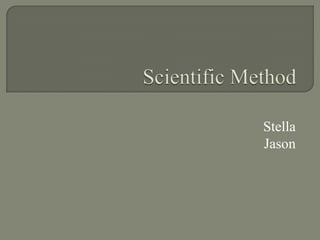
Scientific method (1)
- 1. Scientific Method Stella Jason
- 2. What distinguishes science from non-science is a distinctive method.
- 3. Inductivism:the traditional scientific method Observation Hypothesis Experiment Law Theory
- 4. Observation Observe and classify the relevant data
- 5. Hypothesis Look for a pattern in the data and formulate a hypothesis
- 6. Experiment Make a prediction
- 7. A good experiment should have following features: Controllability: vary only one factor at a time Measurability: measure the relevant variables Repeatability: the experiment can be repeated
- 8. Law Experimental results confirm the hypothesis Discover a scientific law Experimental results disconfirm the hypothesis Think again
- 9. Theory Develop a theory which explains and unifies various laws Explain why the laws are the way they are and provide a focus for further research
- 10. Problems with observation Relevance: we have overlooked a factor that later turns out to be relevant Expectations: our expectations can influence what we see Expert seeing: the use of scientific equipment make observation further complicates things The observer effect: the act of observation can sometimes affect what we observe
- 11. Confirmation Bias People tend to look for evidence that confirms their beliefs and overlook evidence that goes against them
- 12. Scientific Method Example:The Doppler Effect
- 15. Hypothesis He theorized that, since the pitch of sound from a moving source varies for a stationary observer, the color of the light from a star should alter according to the star's velocity relative to Earth. All stars emit white light and that the color of some of the stars was owing to their motion toward or away from us
- 16. Experiment Doppler set up an experiment using two groups of trumpeters One group set up at a train station while the other set up on a train car that was to be pulled past the station. Both groups were to play the same note and Doppler's theory stated that the notes would be dissonant (that the frequencies would be different). This turned out to be true; the notes were audibly different, even though both groups of musicians were playing the same note
- 17. Law/Theory The change in frequency of a wave for an observer moving relative to the source of the wave As the source of frequency emission (E.g. a train) moves toward the observer, there forms a compression for the frequency between the source and the observer reducing the length of the waves which in effect increase the frequency and in turn the pitch.
- 18. Works Cited Erim, Han. "Doppler Effect." Alice In Physics. 8 Aug. 2010. Web. 15 Nov. 2010. Lagemaat, Richard Van De. Theory of Knowledge for the IB Diploma. Cambridge: Cambridge UP, 2005. Print. Roguin, A. "Christian Johann Doppler: the Man behind the Effect -- Roguin 75 (895): 615." The British Journal of Radiology (2001). The British Journal of Radiology. 15 Apr. 2002. Web. 15 Nov. 2010.
